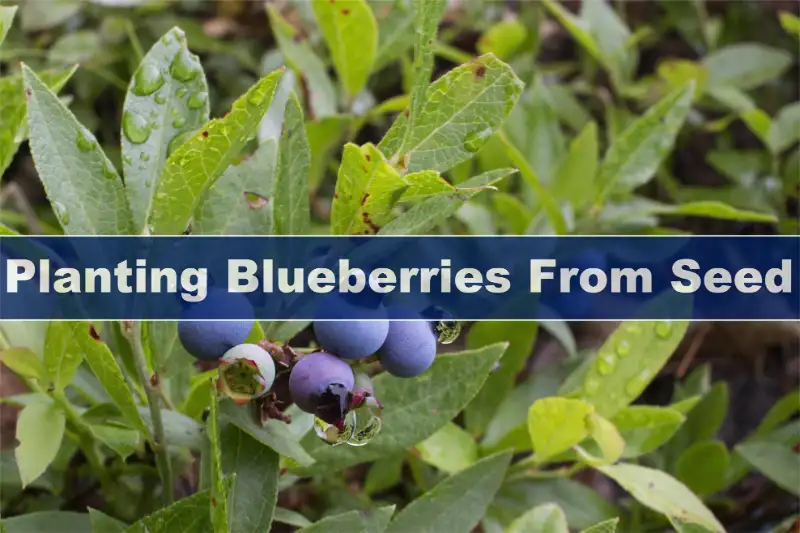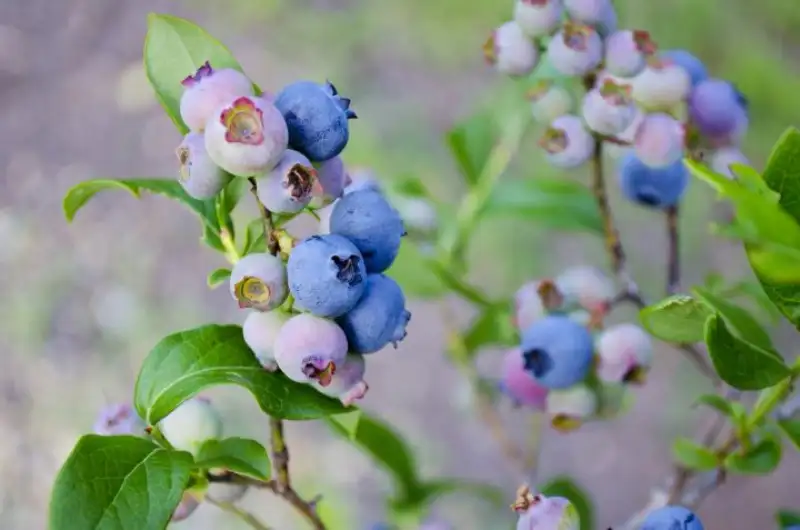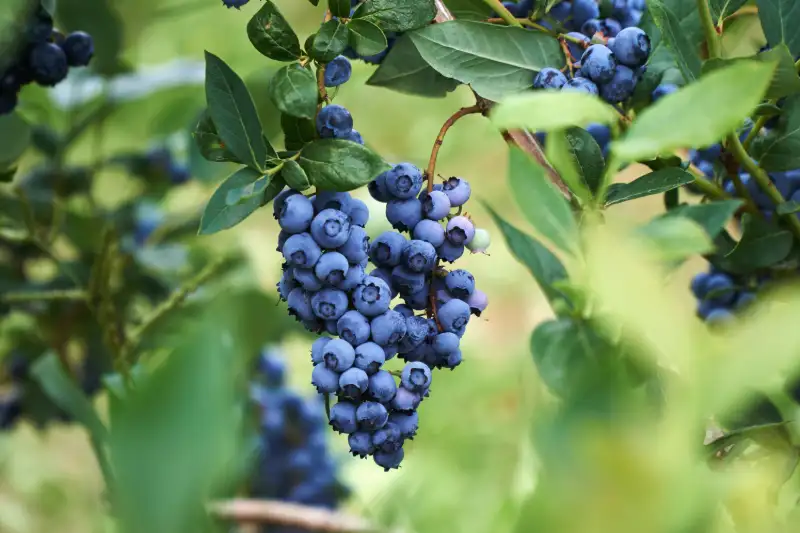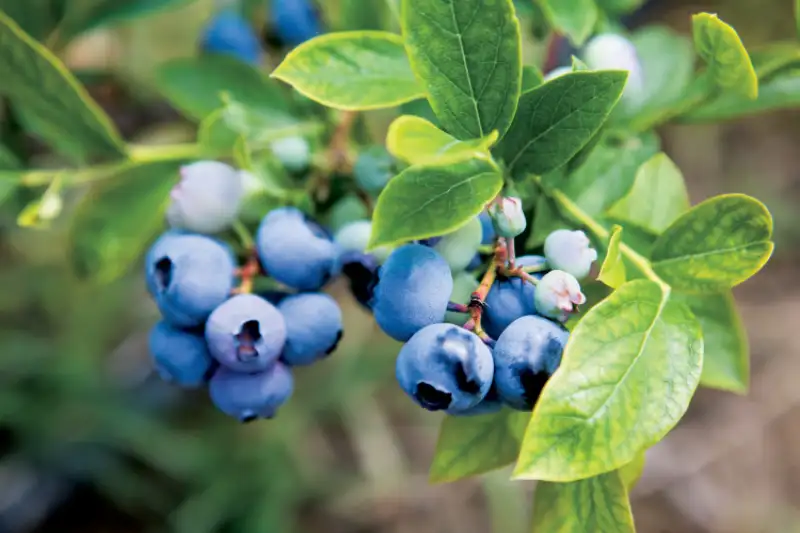Welcome to our BLOG about planting blueberries from seed for beginners.
Plump, juicy blueberries aren’t just tasty. They are FULL of nutrients, fibers, and vitamins.
Fortunately, growing blueberries is an easy task. But many gardeners don’t REALLY KNOW how to do so.
Don’t WORRY if you are also a beginner in this regard. Because here we are, THE BERRY EXPERTS.
Our team has years of EXPERIENCE providing solutions to gardeners. We help them to GET THE MOST out of their gardens. With our EXPERT GUIDANCE, you are ensured to GET the tasty berries you want.
I ASSURE you, after reading this blog; you don’t need to be ANXIOUS about your favorite berries.
So get ready to learn how to plant blueberries from seeds!

When Should You Plant Blueberries?

The IDEAL time to plant blueberries DEPENDS on the climate and your location. Generally, I prefer to grow blueberries in the late fall or early spring.
But why would I prefer that? Right?
Here is the reason.
It ALLOWS the plant to ESTABLISH a strong root system before the growing season BEGINS.
In areas with MILD winters, blueberries can be PLANTED in the fall or winter. Contrarily, it is best to WAIT UNTIL the danger of frost has PASSED before planting in colder areas.
- If you PLAN to grow blueberry seeds, starting them INDOORS in the spring is best.
- Once they begin EMERGING, place them in a SUNNY window or greenhouse.
Note: It is vital to CHOOSE a location with well-draining soil and plenty of sunlight.
Blueberries PREFER acidic soil between 4.5 to 5.5. That is why I choose to test and amend the soil if necessary before planting.
Suggested reading: Do Squirrels Eat Blueberries?
Ideal Growing Conditions for Blueberries

Blueberries are RELATIVELY easy to grow. You just need to provide them with PRECISE growing conditions.
Here are some IDEAL growing conditions for blueberries.
Sunlight
Blueberries REQUIRE full sun to grow and produce berries. ON AVERAGE, they need at least six hours of direct sunlight daily.
Getting my point?
Therefore, I PREFER planting my blueberries in an area with PLENTY of sunlight. And avoid those areas that are SHADED by buildings or trees.
Temperature
Although, blueberries require A LOT of sunlight. Still, they are best SUITED to cool climates.
The IDEAL TEMPERATURE for blueberries ranges from 60°F to 70°F during the daytime.
In an area with HOT summers, providing shade during the HOTTEST SEGMENT of the day is ESSENTIAL.
Soil
LISTEN! Blueberries require acidic soil with a pH between 4.5 to 5.5.
The soil also must be rich in
- Organic matter
- Well draining soil
- The capability of holding moisture.
TEST the soil before planting to ensure it’s within the ideal pH RANGE.
GENERALLY, I add some sulfur or acidic soil to LOWER the pH if the soil is TOO alkaline.
Water and Fertilizer
Blueberries require CONSISTENT moisture but don’t like to be waterlogged.
Therefore, it is crucial to KEEP the soil moist, ESPECIALLY during the fruiting season.
Water your berries DEEPLY once a week or more during the hot, dry weather.
But is there any way to water directly to the roots?
Well! I usually use a soaker hose or drip irrigation to deliver water directly to the roots.
And what about feeding the plant? Right?
It is ideal for fertilizing ONCE in the early spring and AGAIN in the late spring. The growing blueberry seed plants can also be fertilized with liquid fertilizer after two to three weeks in their pots.
Once ESTABLISHED, young plants like acid fertilizers such as azalea formulations.
NOTE: Take proper care when fertilizing because blueberries are very SENSITIVE to over-fertilization.
Suggested reading: How To Pick Blueberries? SUITABLE Techniques
Steps of Planting Blueberries from Seed

Growing blueberries from seed can be a REWARDING experience. But it does REQUIRE patience and attention.
Here are the STEPS to germinate blueberry seeds:
Selecting a Plant Site
Blueberry plants REQUIRE FULL sun to grow healthy. So, PICK a spot that receives SUFFICIENT sunlight but shelters from strong winds.
But that’s not ENOUGH.
- Blueberries need ACIDIC, well-drained soil with a high organic matter content.
- Proper drainage is CRUCIAL because the delicate root system needs ADEQUATE aeration.
- The roots of the blueberries SUFFOCATE if they remain in water-saturated soil for A FEW days.
Proper Spacing and Planting
Blueberry bushes must be SPACED in a row about 4 to 5 feet apart. While the ADJACENT rows should be spaced 9 to 10 feet apart to provide PLENTY of room.
- In the case of BARE-ROOT plants, SPREAD the roots out into the prepared hole.
- Cover them with soil and MAKE SURE the root ball is NOT MORE than 1/2 inch below the soil.
Care the Plant
After planting your blueberries with PROPER spacing, it is CRUCIAL to take good care of them.
But how can you do so?
There are CERTAIN TIPS you must FOLLOW while caring for your plant. Let’s DISCUSS all of these factors briefly.
Water
- Water the seeds GENTLY, being careful not to WASH them away.
- Keep the seedlings MOIST but make sure not to waterlog the soil.
- Try to water the blueberry seed with rainwater, not tap water. Unless you don’t have an ALTERNATIVE in a drought.
Light
To germinate a blueberry seed, you need to provide PLENTY OF BRIGHT LIGHT.
- Place the container in an area where it gets bright sunlight.
- Make sure to keep the temperature between 60 to 70°F.
Fertilizer
Before planting blueberries, add phosphorus and potassium into the soil, if NEEDED.
But once the seeds are ESTABLISHED, blueberries like acid fertilizers such as
- Rhododendron
- Azalea formulations
Take care when fertilizing since blueberries are very SENSITIVE to over-fertilization.
But what’s the ideal time to fertilize the blueberry bush? Right?
LISTEN! It is ideal to fertilize once at the beginning of spring and again in the late spring. Be sure to water thoroughly after fertilizing.
Pruning
The germination rate of blueberry seeds is prolonged.
The first seeds will start to germinate in about a month and finish germinating over 2-3 months. Therefore, pruning is rarely needed in the first two years.
Just REMOVE any crossing or misplaced branching. Once established, pruning REGULARLY keeps the plant healthy and productive.
Prune while the plant is DORMANT in late winter or early spring when the threat of frost has PASSED.
- Initially, clean up the plant by REMOVING any dead, diseased, or crossing branches.
- Then cut out a QUARTER of the old branches, which are thicker and pale gray.
- Blueberries have a tendency to send out HORIZONTAL branches close to the ground. These branches also need to be removed.
- You can also cut the SPINDLY tips of branches to keep your plant more COMPACT.
Caring Technique for Your Blueberries

If you have PLANTED your blueberries, it is ESSENTIAL to care for them to ENSURE healthy growth.
But which factors need to be considered while caring?
Here are some SPECIFIC aspects you MUST FOLLOW to care for your blueberries.
Light
Blueberries grow excellently in areas with FULL SUN EXPOSURE. They need at least 5-6 hours of full sunlight each day.
But what’s the reason behind it?
LISTEN! More sun helps the blueberries to PRODUCE more healthy fruit.
That’s why you might have NOTICED blueberry plants in PARTIAL shade have FEWER fruits.
Soil
As we know, blueberries PREFER a slightly acidic soil ENVIRONMENT.
Therefore, I LIKE to add peat moss or pine bark to the soil if an AMENDMENT is needed.
It HELPS the soil to reach the correct pH level.
Water
Blueberries need CONSISTENT moisture to grow healthy and still prefer to avoid waterlogging.
- Thus, water the blueberries deeply by TARGETING the root area. The fruit’s roots are shallow, making it EASIER for blueberries to dry.
- When the TOP FEW inches of the soil feels dry, you will know it’s time to water AGAIN.
- Frequent light watering is better than HEAVY soaking. When watering, do your best to KEEP the leaves dry.
Fertilizer
Blueberries BENEFIT from regular fertilization. But be careful about FEEDING your individual plants.
It is because blueberries are SENSITIVE to certain fertilizers. Especially during the first year of growth.
Therefore, avoid fertilizers that contain weed killers or pre-emergent herbicides.
Then which fertilizer is best for the blueberry bush?
WELL! I prefer to use BALANCED fertilizers that are specially FORMULATED for blueberries.
These include,
- Espoma Holly-tone
- Jobe’s Organics Acidic Plant Food
Harvesting
You harvest blueberries when they are plump and firm with DEEP blue color. Usually, the berry ripens in mid to late summer.
Hence, blueberries are partially self-fertile.
So, planting MORE THAN ONE type can extend the harvest season. Thus, inducing the plant to produce more berries.
- Harvest blueberries by GENTLY TWISTING them off the stem.
- Be careful not to DAMAGE the fruit or the plant.
Blueberries can be KEPT in the refrigerator for up to a week or freezer for LONGER storage.
How Are Blueberries Propagated?

Usually, there are many METHODS used to propagate blueberries like
- Cutting
- Layering
- Sucker
I THINK cutting is a MORE EFFICIENT and easy method than the others.
Therefore, I mostly CHOOSE softwood and hardwood stem cuttings to PROPAGATE blueberries.
Let’s discuss both softwood and hardwood propagations in detail.
Softwood Cuttings
- Take cutting in the early spring from NEW GROWTH that is still green and flexible.
- Select a piece of stem that is about 5 inches tall. The cuttings start to get WOODY but still flexible.
- Trim it with sharp scissors and remove all. LEAVE the top two or three pairs of leaves.
- Never let the cuttings DRY OUT. Plant them IMMEDIATELY in the moist growing medium.
Hardwood Cutting
- Take hardwood cutting in the late winter, after the bush has gone DORMANT.
- Select a healthy-looking stem that is ALMOST ONE YEAR OLD and contains SEVERAL nodes.
- Cut it into 5-6 inches tall lengths.
- Now stick the cutting in a WARM AREA with indirect sunlight. Keep the medium MOIST but not wet.
- After 3-4 months, they will be rooted and produce new growth. They will be ready to transplant outside.
Common Pests & Plant Diseases
The blueberry bush is SUSCEPTIBLE to several DIFFERENT pests and diseases. So it is better to use regular pesticides and a garden fungicide if you see any sign of pests.
Let’s discuss some most common pests and diseases include:
Powdery Mildew
Powdery mildew is a leaf disease, one of the MOST COMMON diseases among blueberry plants.
A fungal disease that triggers a white, powdery coating on the
- Stems
- Leaves and
- Fruit
It particularly FLOURISHES in areas with LOW light intensity and inadequate airflow.
Now let’s talk about some symptoms of this disease.
Symptoms
- Faint white powder on the UPPER surface of older leaves.
- Leaves DEVELOP chlorotic spots with red borders.
- In some cases, leaves DROP from the plant.
Mummy Berry
A fungal disease that IMPACTS berry growth and SEVERELY damages fruit production.
And what are the symptoms of this disease?
Symptoms
- The symptoms usually appear in the LOWER stems, closer to the soil.
- It actually causes the fruit to SHRIVEL and turns into hard, black mummies. These mummies RELEASE spores that can INFECT the new growth also.
- The SWELLING of new shoots that can occur in the spring. The swollen shoot can have a cottony GROWTH on the outside.
- Diseased bushes will have young dead leaves.
Anthracnose
Anthracnose is a SERIOUS pre- and post-harvest fruit rot REGARDING the blueberry plant.
Symptoms
- Anthracnose can cause IRREGULAR spots on the blueberry leaves. These spots can cause the leaves to TURN yellow and drop PREMATURELY.
- The disease can cause twig blight in the blueberry plant.
- If the condition is SEVERE, it can cause DEFOLIATION of the blueberry bush leading to REDUCE yield.
FAQs about Planting Blueberries From Seed
1. How long does it take to grow blueberries from seeds?
Blueberry seeds are slow GERMINATORS.
Yes! They have a low germination rate, and hence the first seed starts to GROW in about a month. But it will finish germinating over the next 2-3 months.
On the other hand, blueberries grown from seed will take 3 to 4 years to BEAR FRUIT.
2. Can you grow blueberries from store bought blueberries?
Uh! Yup, it is possible to grow blueberries from store-bought blueberries.
Still, the resulting plant is not GUARANTEED to produce the SAME fruit quality.
The reason is that store-bought blueberries are OFTEN treated with chemicals. So they are not suitable for propagation.
3. Are blueberries hard to grow from seed?
Growing blueberries from seed can be CHALLENGING and TIME-CONSUMING. The seeds NEED to be stratified and planted in well-draining soil.
Listen! It takes various years for the plant to REACH maturity and produce fruit. Therefore, it is generally RECOMMENDED to propagate blueberries from
· Cuttings
· Layerings, or
· Divisions
4. What not to plant near blueberries?
It is RECOMMENDED not to plant some SPECIFIC plants near blueberries. It is because they can COMPETE for nutrients and water.
Also, they can ATTRACT pests that can HARM blueberry plants.
These plants include the following:
· Tomatoes
· Potatoes
· Peppers
· Melons
· Brussels
What’s Next
You have got SO MANY details about planting blueberry seeds.
If you are PLANNING to grow blueberry seeds, start them indoors in the EARLY spring. Transfer them outside when the weather warms up.
It is also CRUCIAL to provide the seedlings with ideal growing conditions. And prevent them from DIFFERENT pests to ensure HEALTHY growth.
That’s all for today.
If you WANT TO LEARN more about berries and other fruits, visit AsterGardening.
I GUARANTEE that you will get the BEST QUALITY techniques HERE. So, if you have any ROADBLOCK, reach out to us.
